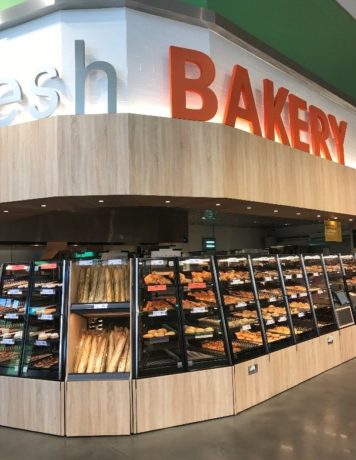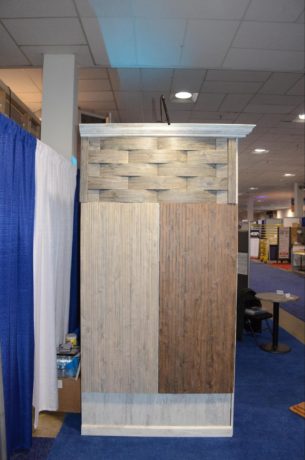U.S. Furniture Orders Grow in October
January 2018
U.S. furniture factory orders grew 8% in October 2017 over the same period in 2016. According to the monthly report of residential furniture manufacturers and distributors, shipments increased 8% over October 2016. Receivable levels increased 1% over October 2016, very much in line with shipments.
Inventories were up 5% over October 2016. October levels seemed to get back in line with current business conditions.

Source: Shipperoo
U.S. Kitchen Cabinet Sales Up
January 2018
U.S. kitchen and bath cabinetry sales in November 2017 rose 1.8% from November 2016, according to the Kitchen Cabinet Manufacturers Association’s (KCMA). Year-to-date cabinetry sales increased 2.8% over the same period in 2016. Semi-custom sales were up 3.7% in November and were 3.5% higher through the first 11 months compared to 2016. Custom cabinetry sales improved 2.2% from the same month last year. Stock sales inched upward by 0.1% in November and year-to-date sales increased from 2016 by 3%.

A kitchen decorated by STF
Marseille In Action
January 2018
What do you think of when hearing the word Laminates?
Typically the response we hear has been kitchen cabinets. However, within recent years 3D laminates have expanded into other markets such as retail fixtures, wall paneling, healthcare, and education. As a more versatile material than traditional laminates to work with, the applications are endless for any project.
Take a look, at the gallery below to see the range of applications for a local grocery chain that utilized STF’s Marseille.



U.S. Housing Market
January 2018
“There’s no place like home.” A quote from the classic movie, The Wizard of Oz, has become the mantra for many Americans who are pursuing the American Dream of homeownership. Reaping the benefits of the growing economy; healthy job market and income growth has fueled demand for houses, including more millennial first-time buyers. Existing-home sales surged for the third straight month in November and reached their strongest pace in almost 11 years. According to the National Association of Realtors, existing homes sales were up 5.6% in November over October, a seasonally adjusted annual rate of 5.81 million. The fastest pace since July 2007, new single-family house sales increased 17.5% in November over October to a seasonally adjusted annual rate of 733,000. This is a 26.6% increase over the same time last year.
“The greater home sales will stoke the fires for stronger economic growth next year as consumers spend more to furnish their new homes with new appliances and furniture and all the decorations and trimmings,” said Chris Rupkey, chief economist MUFG in New York. Even though the housing market has experienced robust growth at fast paces there are continuing constraints that will affect the housing market going into 2018. Total housing inventory at the end of November decreased 7.2% and has fallen year-over-year for 30 consecutive months. Current inventory levels are at a 3.4 month supply. Low inventory has elevated home prices and has sidelined some first-time buyers who cannot find suitable lower end market homes. Due to low inventory, the median home price has increased 5.8% from a year ago, the 69th consecutive month of year-on-year price gains.
 Additionally, for new homes being built, a consistent shortage of skilled labor and lots has tightened many builders ability to add new homes to the market. Builders are pushing for more housing starts, with a 3.3 percent increase in housing starts in November over October. However, the supply is unable to keep up with current demand.
Additionally, for new homes being built, a consistent shortage of skilled labor and lots has tightened many builders ability to add new homes to the market. Builders are pushing for more housing starts, with a 3.3 percent increase in housing starts in November over October. However, the supply is unable to keep up with current demand.
The National Association of Realtors says it anticipates a slightly negative impact on the housing market from the overhaul of the U.S. tax code. The cap for property and state and local income tax is now set at 10,000, the prospect for a bigger tax bill may discourage some buyers. Moody's Analytics chief economist Mark Zandi has warned that the tax revamp would weigh on house prices, with the Northeast corridor, South Florida, big Midwestern cities, and the West Coast suffering the biggest price declines.
New Home Sales Hit a 10-Year High
December 2017
Sales of new U.S. single-family homes unexpectedly rose in October to a 10 year high. In October, sales were at a seasonally adjusted annual rate of 685,000. This is a 6.2% increase over September 2017 and an 18.7% increase over October 2016. The sale of new homes sales consists of eleven percent of overall home sales.
Mild weather helped to boost new home sales last month. Sales soared 30.2% in the Northeast to their highest level since October 2007. They rose 1.3% in the South also to a 10-year high. Sales jumped 17.9% in the Midwest and climbed 6.4% in the West.
Existing home sales also increased in October to their strongest pace since earlier this summer, a 2% increase over September. But supply shortages have continued to lead to fewer closings on an annual basis for the second straight month.

US Jobs Report More Gains
December 2017
The U.S. job market has finally begun to shake off the last impacts of the hurricane season that hit Florida and Texas earlier this year. In November, 228,000 nonfarm jobs were added to the economy, as the unemployment rate remained at a 17 year low of 4.1%.
Most notably, the manufacturing segment had the largest gains with a 1.5% increase in jobs in 2017 over 2016. Manufacturers added 31,000 jobs during November alone, with unemployment in this sector at 2.6%, the lowest on record for the series since January 2000.

Topping of the Year
December 2017
STF is ending 2017 on a high note by adding one more design to our growing RTF collection: Try Cherry.
A medium tone grey woodgrain, Try Cherry is perfect to add a timeless look to your design. With grey tones here to stay, Try Cherry is sure to be the cherry on top for any project.
The corresponding TFL can be found from Tafisa: Grenada (L499) and Panolam Trytoo Savatre (W155).

The New Target Consumer: Millennials
November 2017

Source: Media Venue
Millennials, a term that we have begun to hear more often, that refers to the age of people born roughly between 1980 and 2000 that has peaked at 93 million people. Baby boomers, born between 1946 and 1964, numbered 78.8 million at their peak and today have 74 million, according to the 2016 U.S. Census Bureau.
The largest single age cohort today in the U.S. is the 26-year-old, who number 4.8 million. People 25, 27, and 24 following close behind. Many of these are on the verge of life-defining moments such as choosing a career, buying a house and having children.
As a whole, the largest demographic bubble they have begun to transform popular culture, retailing, media, and lifestyles. According to Zillow Group, they make up for about 42% of all home buyers and 71% of all first time home buyers. They are also more likely to invest in their home, with 86% of millennial home buyers making at least one improvement to their home in the past year, more than any other generation.
The millennial influence has already begun to shape today’s design trends that focus on key elements such as long-term use, functionality, eco-friendly and cost-effectiveness.
Millennials are more motivated on making sure style, color, and materials used to stay relevant as long as possible. That includes the use of more neutral colors such as whites and greys in finishes such as high gloss and super matte for a beautiful contemporary design that will always be in style. There is also a heavy emphasis on eco-friendly products, making value-engineered wood products a go-to solution because of the versatility of the products along with many options for finish and design type.
Supassing Expectations: US Economy
November 2017

Source: Simply Hired Blog
The US economy continues to surprise economists and with no signs of slowing down despite the impact of two hurricanes in the Southeast. Exceeding original forecasts, GDP growth in the third quarter of 2017 reached 3% following a GDP growth of 3.1% in the second quarter.
The GDP growth can be attributed to an increase in inventories, exports, and consumer spending during the third quarter. U.S. consumer spending recorded its largest increase in more than eight years, according to the Bureau of Economic Activity there was a 1% increase in September, likely as those affected by hurricanes replaced flood-damaged vehicles.
Along with GDP growth, jobs within the U.S. have also continued on an upward trend. With 261,000 jobs added in October, unemployment fell to an unprecedented rate of 4.1%, the lowest since 2000. This marks the 85th straight month of job growth within the U.S.
The manufacturing sector has seen its 14th straight month of expansion according to the Institute for Supply Management’s report on Business. Of the 18 manufacturing industries, 16 reported overall growth with continued growth in new orders, production and employment.
Amidst a booming economy, the U.S. housing market has also begun to see some noteworthy figures. New single-family home sales had an 18.9% increase in September over the August 2017 rate and a 17% increase over the September 2016 estimate.
The sale of existing home sales finally began to rebound in September with a 0.7% increase after three straight months of declines, but ongoing supply shortages and recent hurricanes have muted the overall activity.
Altogether these indicators point towards continued expansion and a healthy outlook for the U.S. economy going into the 4th quarter and 2018.
WMS In Review
November 2017
The 2017 Woodworking Machinery & Supply Expo (WMS) that took place on November 2-4, 2017 in Toronto, Ontario ended on a high note for STF. With nearly 4,400 attendees and over 270 companies and brands represented this has been one of the largest turnouts for the WMS biannual show.

At this year’s WMS, STF showcased our new ULTRA laminate program, a new 1D laminate that comes in 2 finishes: ultra-gloss, and ultra-matte. Attendees were captivated by the high gloss finishes that reflected so well, they could be used as a mirror! Additionally, we demonstrated the high scratch resistance in both finishes, a unique feature that makes it stand out from other laminates.
Another hot topic at our booth was our new line of solid colors. Greys have been the fastest trending color in the kitchen cabinet industry and STF was proud to display range of solid greys: Folkstone Grey, Gun Metal Grey, and Battleship Grey. Each of these designs has a corresponding TFL and HPL matches (see below). Alongside the greys, Deep Blue Sea received a lot of buzz as being a nice subtle color to add to any finished design and we think blue is the new grey!
Synergy also exhibited our in-depth matching programs with major TFL and HPL manufacturers such as Tafisa, Uniboard, and Arauco to demonstrate the seamless design possibilities when working with STF’s products. But we did not stop there, additionally presenting the versatility of thermofoil from crown molding to the intriguing decorative wall paneling.


Deep Blue Sea Nevamar Deep Blue S3022 Panolam Deep Blue 3022 Sherwin Williams Gale Force 7605

Battleship Grey Tafisa Sundown L768 Arborite T768 Sundown Sherwin Williams Peppercorn 7674

Folkstone Grey Wilsonart Fashion Grey D381 Tafisa Summer Drops L202 Uniboard Sunset Grey 805 Sherwin Williams Knitting Needles 7672

Gun Metal Grey Arauco Fossil SF233 Panolam Fossil FB2330 Formica Citadel 1097 Sherwin Williams Gauntlet Grey 7019
Join STF at WMS in Toronto!
October 2017
Come stop by STF’s booth at this year’s Woodworking Machinery & Supply Conference and Expo!
We will be there on November 2-4 at the International Centre in Toronto, Canada.
STF will be displaying our latest solids additions as well as the new ULTRALAM 1D laminate series.

Economic Activity in the U.S. After Hurricane Irma
October 2017
The U.S. economy shows no signs of slowing down, despite the impact of two major hurricanes that hit U.S. mainland within two weeks of each other. Damage done by high winds and rampant flooding in Texas and Florida (the 2nd and 4th largest economies in the U.S.) was forecasted to negatively impact third-quarter economic activity but as of yet the U.S. economy appears to be more resilient than in the past.
According to the World Economic Forum, the U.S. gained in global competitiveness for the 2017-2018 Global Competitiveness Index. The U.S. is now ranking number 2 out of 137 countries, the highest it has been since the beginning of the 2008 recession. This report assesses the competitiveness landscape based on 12 pillars (1), which provides insight into the drivers of their productivity and prosperity. Another positive outlook for the U.S. economy has been the reduction in the trade deficit for August, decreasing the deficit by 2.7% from July 2017. The August trade deficit came in at $42.4 billion, which is the lowest it has been in 11 months.
Even with a loss of 33,000 jobs, mostly in the service and hospitality industry due to hurricane impacts, unemployment decreased yet again. At its lowest, since February 2001, the unemployment rate is now at 4.2%. Economists predict that the loss of the total number of jobs will quickly be rebound as the areas impacted by hurricanes get back to normal.
With manufacturing driving the U.S. economy, 17 of 18 manufacturing sectors have reported growth according to the Institute for Supply Management (ISM) Report on Business (2). Manufacturing expanded in September as the PMI (Purchasing Managers Index) registered at 60.8%, an increase of 2% from the August reading of 58.8% and the highest since May 2004 at 61.4%. The September PMI indicates growth for the 100th consecutive month in the overall economy and the 13th straight month of growth in the manufacturing sector. The largest growth can be seen in new orders, up 4.3% and production rose 1.2%.
____________________________
(1) The 12 pillars used to measure global competitiveness include institutions, infrastructure, macroeconomic environment, health and primary education, higher education and training, goods market efficiency, labor market efficiency, financial market development, technological readiness, market size, business sophistication, and innovation.
(2) The 18 manufacturing industries include: Textile Mills; Machinery; Nonmetallic Mineral Products; Transportation Equipment; Plastics; Rubber Products; Paper Products; Wood Products; Computer; Electronic Products; Food, Beverage; Tobacco Products; Chemical Products; Fabricated Metal Products; Miscellaneous Manufacturing; Petroleum; Coal Products; Apparel, Leather; Allied Products; Printing; Related Support Activities; Electrical Equipment, Appliances; Components; Primary Metals; and Furniture; Related Products.





 Additionally, for new homes being built, a consistent shortage of skilled labor and lots has tightened many builders ability to add new homes to the market. Builders are pushing for more housing starts, with a 3.3 percent increase in housing starts in November over October. However, the supply is unable to keep up with current demand.
Additionally, for new homes being built, a consistent shortage of skilled labor and lots has tightened many builders ability to add new homes to the market. Builders are pushing for more housing starts, with a 3.3 percent increase in housing starts in November over October. However, the supply is unable to keep up with current demand.










